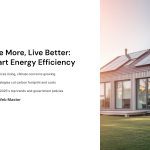 Energy prices are rising, and climate change concerns are driving both governments and consumers to take a closer look at how we use power in our homes and businesses. From AI-powered thermostats to solar panels and energy-efficient appliances, saving energy is no longer a trend—it’s a necessity. But what if energy-saving strategies didn’t just cut your carbon footprint, but also helped you earn more or live better? This post explores the real-world benefits of smart energy efficiency practices and why adapting them today is a step toward a wealthier, greener tomorrow. Plus, we’ll uncover 2025’s top trends in energy efficiency, updated policies from major governments, and predictions on where this transformation will lead us.
Energy prices are rising, and climate change concerns are driving both governments and consumers to take a closer look at how we use power in our homes and businesses. From AI-powered thermostats to solar panels and energy-efficient appliances, saving energy is no longer a trend—it’s a necessity. But what if energy-saving strategies didn’t just cut your carbon footprint, but also helped you earn more or live better? This post explores the real-world benefits of smart energy efficiency practices and why adapting them today is a step toward a wealthier, greener tomorrow. Plus, we’ll uncover 2025’s top trends in energy efficiency, updated policies from major governments, and predictions on where this transformation will lead us.

Understanding Energy Efficiency: Why It Matters Now More Than Ever
Energy efficiency isn’t just about using less energy—it’s about using energy smarter. With rising fuel costs and growing environmental concerns, there’s an urgent need to rethink how we consume power. Every watt saved is not just a cost avoided, but also a reduction in our carbon footprint. Energy-efficient buildings, appliances, and behaviors can cut down global emissions by up to 40% by 2040 according to the International Energy Agency. In 2025, we see more tax incentives, stricter efficiency regulations, and an increase in public awareness pushing this trend forward. Consumers now have access to smarter solutions that integrate seamlessly with modern life—making energy-saving both accessible and stylish.

Smart Technology: Revolutionizing Energy Use at Home and Work
Smart thermostats, motion sensors, and AI-powered lighting systems are leading the way in home energy management. These devices don’t just turn off when not in use—they learn your behaviors and optimize energy use automatically. Businesses are leveraging building management systems (BMS) that analyze real-time data to cut down waste and improve operational efficiency. The 2025 market for energy-saving smart devices has grown by over 35%, especially in North America and Asia-Pacific regions. This trend is likely to continue, driven by stricter ESG (Environmental, Social, Governance) requirements and rising electricity costs.

Government Policies and Incentives You Shouldn’t Miss in 2025
Governments worldwide have rolled out generous incentives for energy-efficient upgrades. In the U.S., the Inflation Reduction Act offers tax credits for heat pumps, solar panels, and energy audits. South Korea has introduced subsidies for energy storage systems (ESS) and AI-integrated appliances. In the EU, “Fit for 55” packages are pushing for near-zero energy buildings. Understanding and leveraging these policies is key to maximizing savings and improving property value. Ignoring them isn’t just missing out on rebates—it’s leaving money on the table and falling behind on compliance.

Cost-Benefit Analysis: When Saving Energy Saves You More Than Just Bills
Many still believe that going green is expensive, but the data proves otherwise. Upfront costs are often recouped within a few years due to significant drops in monthly bills. For example, switching to LED lighting can reduce electricity use by 75%, while smart HVAC systems can save up to $150 annually per household. Businesses investing in efficiency see increased ROI through improved brand perception and compliance. Furthermore, energy-efficient homes sell faster and at higher prices. Energy-saving is not an expense—it’s a strategic investment for the future.

Behavioral Changes: Small Steps That Make a Massive Impact
You don’t need to install solar panels or buy a Tesla to make a difference. Simple changes like unplugging unused electronics, using programmable thermostats, or adopting a cold-water laundry routine can save hundreds of dollars a year. Awareness and consistency are key. Gamification apps that track your household’s energy usage and compare it with neighbors’ are trending in 2025, creating a fun, competitive edge to sustainability. Teaching kids about energy-saving habits at a young age builds lifelong responsibility—and helps reduce your family’s footprint significantly.

The Future of Energy Efficiency: What to Expect Next?
The next wave of energy efficiency lies in decentralized grids, peer-to-peer energy trading, and AI-optimized energy contracts. Blockchain will ensure transparency in energy consumption and transactions. More homes will produce energy than they consume, becoming “prosumers” in local energy networks. Carbon footprint tracking will be standard in consenergy efficiencyumer products, and new energy-labeling systems will guide purchasing behavior. With these shifts, those who act early stand to gain not just economically but in lifestyle quality and sustainability leadership.
*Capturing unauthorized images is prohibited*



